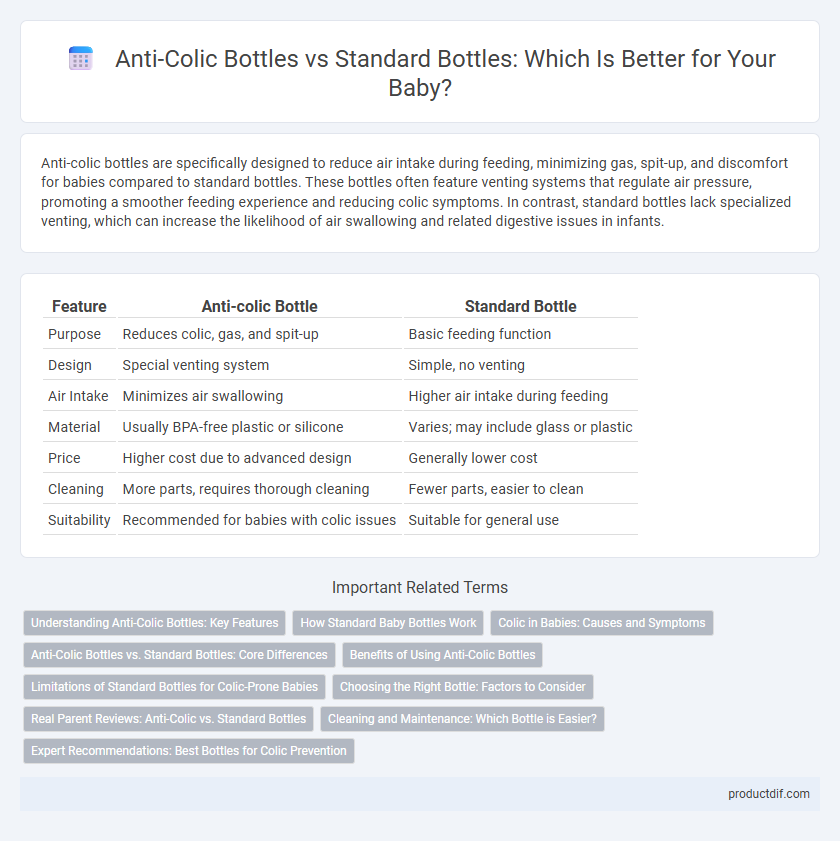Anti-colic bottles are specifically designed to reduce air intake during feeding, minimizing gas, spit-up, and discomfort for babies compared to standard bottles. These bottles often feature venting systems that regulate air pressure, promoting a smoother feeding experience and reducing colic symptoms. In contrast, standard bottles lack specialized venting, which can increase the likelihood of air swallowing and related digestive issues in infants.
Table of Comparison
| Feature | Anti-colic Bottle | Standard Bottle |
|---|---|---|
| Purpose | Reduces colic, gas, and spit-up | Basic feeding function |
| Design | Special venting system | Simple, no venting |
| Air Intake | Minimizes air swallowing | Higher air intake during feeding |
| Material | Usually BPA-free plastic or silicone | Varies; may include glass or plastic |
| Price | Higher cost due to advanced design | Generally lower cost |
| Cleaning | More parts, requires thorough cleaning | Fewer parts, easier to clean |
| Suitability | Recommended for babies with colic issues | Suitable for general use |
Understanding Anti-Colic Bottles: Key Features
Anti-colic bottles feature a venting system that reduces air intake, minimizing gas, spit-up, and discomfort in babies. Their specially designed nipples promote a consistent milk flow, closely mimicking breastfeeding to prevent colic symptoms. Compared to standard bottles, these innovations support better digestion and reduce the risk of colic-related fussiness.
How Standard Baby Bottles Work
Standard baby bottles function by allowing infants to feed through a nipple that releases milk or formula based on the baby's sucking pressure. The simplest bottles have no venting system, often causing air to mix with the liquid, which can lead to gas and discomfort. Understanding this mechanism helps parents recognize why anti-colic bottles, designed with vents or valves, aim to reduce air intake and improve feeding comfort.
Colic in Babies: Causes and Symptoms
Colic in babies often results from excessive gas and digestive discomfort, which can be aggravated by swallowing air during feeding. Anti-colic bottles are designed with venting systems that reduce air intake, minimizing the risk of colic symptoms like intense crying and abdominal discomfort. Standard bottles lack these features, potentially increasing the likelihood of gas buildup and prolonged fussiness in infants.
Anti-Colic Bottles vs. Standard Bottles: Core Differences
Anti-colic bottles feature specialized venting systems designed to reduce air intake, which helps prevent gas, spit-up, and colic in infants, unlike standard bottles that lack these mechanisms. These bottles often use valves or vents to maintain a steady flow while minimizing air bubbles, promoting better digestion and reducing discomfort. Selecting an anti-colic bottle can significantly improve feeding experiences by addressing common infant feeding issues related to air ingestion.
Benefits of Using Anti-Colic Bottles
Anti-colic bottles reduce the amount of air a baby ingests during feeding, which helps prevent gas, fussiness, and discomfort. These bottles typically feature special venting systems that minimize colic symptoms by maintaining a steady flow and reducing air bubbles in the milk. Using an anti-colic bottle supports better digestion and can promote a calmer feeding experience for both infants and parents.
Limitations of Standard Bottles for Colic-Prone Babies
Standard baby bottles often lack venting systems designed to minimize air intake, which can increase the risk of colic and gas in infants. Without specialized anti-colic features, standard bottles may cause babies to swallow air during feeding, leading to discomfort and excessive crying. This limitation makes standard bottles less suitable for colic-prone babies compared to anti-colic bottles engineered to reduce air ingestion.
Choosing the Right Bottle: Factors to Consider
Choosing the right baby bottle involves evaluating factors such as nipple flow rate, material safety, and ease of cleaning, with anti-colic bottles specifically designed to reduce gas and discomfort by minimizing air ingestion during feeding. Standard bottles may suffice for infants without feeding issues, but anti-colic bottles often feature venting systems or valves that promote a smoother feeding experience and reduce colic symptoms. Parents should consider their baby's feeding habits, susceptibility to gas, and preferences when selecting between anti-colic and standard bottles.
Real Parent Reviews: Anti-Colic vs. Standard Bottles
Real parent reviews highlight that anti-colic bottles significantly reduce gas and fussiness compared to standard bottles, improving infant comfort and sleep quality. Many parents report fewer spit-ups and less colic-related crying, attributing these benefits to specialized venting systems in anti-colic bottles. Despite a slightly higher price, the majority of users consider anti-colic bottles a worthwhile investment for easing feeding challenges.
Cleaning and Maintenance: Which Bottle is Easier?
Anti-colic bottles often feature more complex designs with valves and multiple parts, making cleaning and maintenance more time-consuming compared to standard bottles that usually have fewer components. Standard bottles typically have straightforward shapes and wide necks, allowing easier access for thorough washing and faster drying times. Choosing a bottle with dishwasher-safe materials and compatible cleaning brushes can significantly simplify the cleaning process regardless of the bottle type.
Expert Recommendations: Best Bottles for Colic Prevention
Experts recommend anti-colic bottles featuring venting systems designed to reduce air ingestion, which helps minimize gas, spit-up, and colic symptoms in infants. Studies indicate that bottles like Dr. Brown's Natural Flow and Philips Avent AirFree significantly decrease colic episodes compared to standard bottles lacking specialized airflow mechanisms. Pediatricians emphasize choosing bottles with proven venting technology to support smoother feeding and enhanced digestive comfort for colicky babies.
Anti-colic bottle vs standard bottle Infographic

 productdif.com
productdif.com